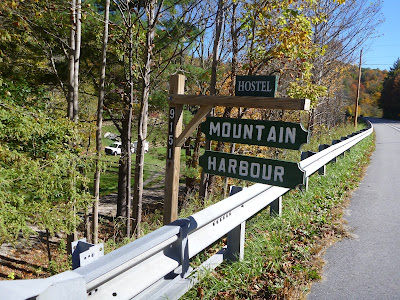Tonight's entree...
Stories are told of potential Appalachian Trail backpackers carrying packs burdened with massive amounts of food, convinced that they'd have no chance to resupply for hundreds of miles as they traversed the wilderness. But as I pointed out in my last post, it's unusual to go more than 4-5 days on the AT without some opportunity for resupply. A 4-5 day supply is still a pretty fair amount of food, so the hiker must make some smart decisions on what to carry. |
| Cooking dinner - near Pearisburg, VA, 2011. |
 |
| Snacking on apples - Greasy Creek Gap, TN, 2014. |
Some hikers will pack freeze-dried backpacking meals, but they tend to be expensive and are usually only carried by weekenders and other short-timers. That leaves dry goods and foods that travel well as the staples of backpacking. Everyone's different, but here's a typical menu for a day on the trail:
Breakfast: Instant coffee (Starbucks Via is the best); protein bar or pop-tarts. In cooler weather I'll sometimes take instant oatmeal so I can start the day off with a hot meal.
Lunch: Tortillas with pepperoni and cheddar cheese. The cheese and pepperoni stay good for a surprisingly long time, even in warm weather.
 |
| Lunch. VA, 2011. |
Dinner: Couscous with tuna or sausage. Couscous is one of my favorites -- you can buy it in bulk; it cooks with very little fuel, and it's light. I'll mix in some olive oil, dried vegetables, and spices to liven it up. Other go-to dinners are instant mashed potatoes, or Lipton noodles or rice side dishes -- one pouch equals one serving for a hungry hiker.
During the day I'll snack on energy bars or Snickers, and I'll often mix my water with drink mixes, like lemonade or sports drink powders. It adds some variety and keeps the calorie count up.
Restocking your provisions
If you're carrying food for 4 days, but planning to hike for 7-10, you've got to resupply. If my route goes through a town with a well-equipped grocery store, it's easy enough to stop in there for the goods I need. But more often I've relied on mail drops to get the supplies I need.Mail drops are an old AT tradition. In the purest form, a hiker mails a box of supplies ahead to the local Post Office, addressed to themselves at General Delivery. Stop by during business hours, show some I.D., and you've got your package. Thru-hikers often utilize mail drops for more than just food. They'll send along extra clothing, spare parts, batteries, phone chargers, and even laptops from town to town, using what's called a 'bounce box." It eliminates the need to carry extra gear they may not need on the trail.
Lodgings along the AT usually accept mail drops, so I can kill two birds with one stone by having a supply of food and other essentials waiting for me at my planned town stops. For this trip I'll start light, and resupply on the third night, when I stay at the Ironmaster's Mansion Hostel.
 | ||
| Most AT hostels and other lodgings will hold mail drops for guests, or for a fee, if you're not a guest. Tennessee, 2014. |












